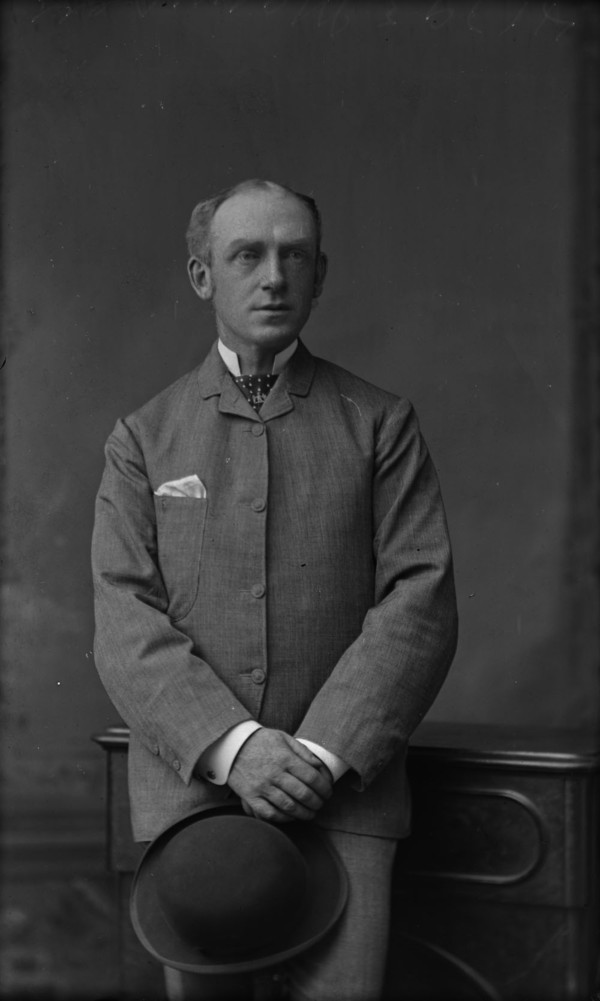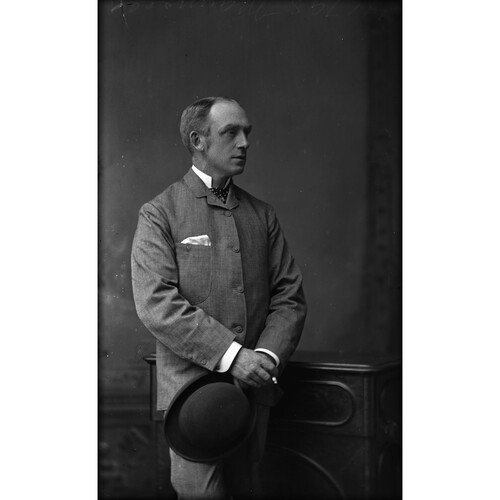MAUNSELL, EDWARD HERBERT, NWMP officer and rancher; b. 14 Oct. 1855 in Ballywilliam, County Limerick (Republic of Ireland), son of Frederick Maunsell and Louise Herbert; m. 10 Aug. 1886 Jeanette Ryan of Tipperary (Republic of Ireland), and they had two daughters and one son; d. 11 Nov. 1923 in Lethbridge, Alta.
Edward Maunsell was educated in Ireland and came to Canada in 1874, where he immediately joined the North-West Mounted Police. Assigned to D Division, he took part in the Long March from Dufferin, Man., to the Sweet Grass Hills (Alta/Mont.). He was with the section of the force under Commissioner George Arthur French that returned to Manitoba, but in 1876 he was transferred to Fort Macleod (Alta). After completing his three-year term in 1877 he went back to Ireland. His familiarity with cattle raising had enabled him to recognize the potential for ranching in the foothills of the Rocky Mountains. He returned to North America, and when his elder brother George Wyndham obtained his discharge from the NWMP in 1878, they undertook to become ranchers.
At that time, since no cattle were available in what is now southern Alberta, the brothers contracted with a Montana firm to deliver 103 head to them in the summer of 1879. Meanwhile, they earned a living near Fort Macleod by growing oats, cutting rails, and filling hay contracts for the mounted police. After receiving the cattle, the Maunsells learned that the land would not be opened to settlement for at least a year, and they worried that starving Indians would slaughter their herds [see Isapo-muxika*]. In the autumn round-up, when they discovered that nearly half their animals had strayed or been killed, with other cattle owners they sent their remaining stock to Montana. By the time the cattle were brought back in 1881, the herd had been further reduced through theft and mismanagement.
A third brother, Henry Frederick, joined Edward and George in 1881, and Maunsell Brothers took homesteads and a lease of 6,500 acres immediately west of Fort Macleod. Initially they prospered, but the terrible winter of 1886–87 ravaged their herd. As a result, George left the partnership to establish his own ranch, while Edward and Harry, as his younger brother was known, remained at the original site. In their partnership, Edward was in charge of the Ivy Ranch (named for his IV brand) and Harry ran the adjacent farm.
In Maunsell’s opinion, the government’s leasing policy for grazing land greatly favoured the huge ranch companies [see Matthew Henry Cochrane*; Frederick Smith Stimson*] and the only way to compete was to expand. Over the years, he became one of the leading cattlemen of the southern District of Alberta. In 1900 he leased the entire Peigan Indian Reserve and in 1901 he added 700 cattle to his herd when he bought out a neighbouring rancher. To increase further the size of his holdings, he entered into partnership with John Cowdry, a private banker in Fort Macleod. They purchased a 200,000-acre grazing lease west of Medicine Hat at Grassy Lake for $100,000 and when the historic Cochrane Ranche was sold to the Church of Jesus Christ of Latter-day Saints in 1905, Maunsell bought its entire herd for $240,000. At its peak, about 1910, the Maunsell ranch had some 15,000 cattle and shipped entire trainloads to the Chicago market.
Changes in its fortunes occurred in the 1910s. The federal government cancelled the Grassy Lake lease without notice, and although the subsequent lawsuit would be settled in favour of Maunsell, thousands of cattle had had to be sold at a tremendous loss. Maunsell suffered a personal blow in 1917 when his son, Frederick William Edward, was killed in France at Vimy Ridge and another in 1919 when his brother George died. The ranching operation experienced further reverses with the destruction of hundreds of stock in the harsh winter of 1919–20 and termination of the lease on the Peigan reserve. The Ivy Ranch was reduced to its freehold land.
In addition to ranching, Edward Maunsell was active in the community. An unsuccessful Liberal candidate for the Legislative Assembly of Alberta in 1910, he served as president of the Macleod Old Timers Association and took an interest in local history and place names. On 13 Oct. 1923, less than a month before his death, the Calgary Daily Herald published a long account of his adventures in the times before the arrival of the large ranch companies. His anecdotes, with their stories of danger and hardship, their humour, and their appreciation of character, bring to life the brief days of the frontier in southern Alberta.
“Epic of the west unfolded by pioneer of ‘70s,” Calgary Daily Herald, 13 Oct. 1923. Lethbridge Herald (Lethbridge, Alta), 6 Jan., 13 Nov. 1923. Alta Geneal. Soc., “Alta cemetery records surname index.”. John Blue, Alberta, past and present, historical and biographical (3v., Chicago, 1924), 2: 102–4. Fort Macleod – our colourful past: a history of the town of Fort Macleod, from 1874 to 1924 (Fort Macleod, Alta, 1977), 341–42. A. O. MacRae, History of the province of Alberta (2v., [Calgary], 1912), 2: 692. “The west of Edward Maunsell,” ed. H. A. Dempsey, Alberta Hist. (Calgary), 34 (1986), no.4: 1–17; 35 (1987), no.1: 13–26.
Cite This Article
Hugh A. Dempsey, “MAUNSELL, EDWARD HERBERT,” in Dictionary of Canadian Biography, vol. 15, University of Toronto/Université Laval, 2003–, accessed April 28, 2025, https://www.biographi.ca/en/bio/maunsell_edward_herbert_15E.html.
The citation above shows the format for footnotes and endnotes according to the Chicago manual of style (16th edition). Information to be used in other citation formats:
| Permalink: | https://www.biographi.ca/en/bio/maunsell_edward_herbert_15E.html |
| Author of Article: | Hugh A. Dempsey |
| Title of Article: | MAUNSELL, EDWARD HERBERT |
| Publication Name: | Dictionary of Canadian Biography, vol. 15 |
| Publisher: | University of Toronto/Université Laval |
| Year of revision: | 2005 |
| Access Date: | April 28, 2025 |





